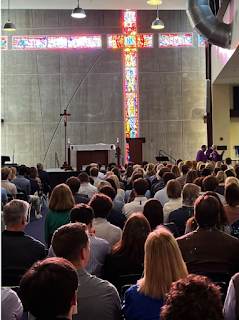Water is Life
At first glance, the readings today seem to contrast one another. Ezekial describes the beauty of the river and the life it brings and will bring to all living creatures that the water touches. While, in apparent contrast, the Gospel tells the story of Jesus healing a sick man by telling him to rise, take his mat, and walk away. What do two seemingly opposite stories have in common? Why are they together on this day?
Water is seen as central to life, Ezekial tells of the fecundity of the land as the water moves throughout the land, bringing forth an abundance of fish, a plentitude of fruit trees providing both sustenance and medicine. Water that clears the salt from the ocean, purifying as it enters into the greater body. In John, we learn that the ill man is discovered by Jesus near a pond in Bethesda known for its healing properties but he is unable to get himself in the water. Water, a powerful element takes on a different meaning in the context of these stories. It is life-bringing and life-saving; both readings offer hope for the future.
The authors call the reader to see beyond the immediate, to see beyond the present circumstance. Ezekial describes a lush land providing all that may be needed for life while demonstrating that more will come as the freshwater purifies the ocean. In John, Jesus sees the ill man and knows his suffering. Jesus calls the man to heal, and he walks away. The pool the man so desperately tried to sink into is not the physical one, but the future found in Jesus. If we see beyond the immediate we will find God in the place or person in front of us.
Water is life, as God is life.
Ezekial and John remind us that God is always present before us, in the elements that make up the earth, the life upon that earth, and, perhaps, most importantly in the person of Jesus.
Author: Michele Elchlepp, Theology Department Chair
Water is seen as central to life, Ezekial tells of the fecundity of the land as the water moves throughout the land, bringing forth an abundance of fish, a plentitude of fruit trees providing both sustenance and medicine. Water that clears the salt from the ocean, purifying as it enters into the greater body. In John, we learn that the ill man is discovered by Jesus near a pond in Bethesda known for its healing properties but he is unable to get himself in the water. Water, a powerful element takes on a different meaning in the context of these stories. It is life-bringing and life-saving; both readings offer hope for the future.
The authors call the reader to see beyond the immediate, to see beyond the present circumstance. Ezekial describes a lush land providing all that may be needed for life while demonstrating that more will come as the freshwater purifies the ocean. In John, Jesus sees the ill man and knows his suffering. Jesus calls the man to heal, and he walks away. The pool the man so desperately tried to sink into is not the physical one, but the future found in Jesus. If we see beyond the immediate we will find God in the place or person in front of us.
Water is life, as God is life.
Ezekial and John remind us that God is always present before us, in the elements that make up the earth, the life upon that earth, and, perhaps, most importantly in the person of Jesus.
Author: Michele Elchlepp, Theology Department Chair



Comments
Post a Comment